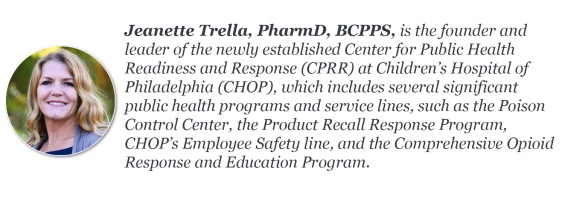Preventing Pediatric Injury from Medical Opioids

Editor’s Note: This post is part of a series taking a family lens to substance use and substance use disorder through solutions that can support children, teens and caregivers. Through harm reduction measures, public policies, and connections between health care systems and community-based services, the authors offer tangible opportunities to address the substance use crisis impacting families in our community and across the country. PolicyLab developed the series in partnership with Children’s Hospital of Philadelphia’s Comprehensive Opioid Response and Education (CORE) Program. Read “Naloxone is Going ‘Over the Counter:’ Will it Reach Our Kids?”
Within the first months of this year, the Children’s Hospital of Philadelphia (CHOP) Poison Control Center has already helped manage multiple tragic cases of pediatric deaths thought to be related to opioids. In fact, opioids are the most common cause of fatal poisonings in young children. And, in line with the worsening opioid overdose crisis in the U.S., the contribution of opioids to childhood poisoning fatalities has increased in recent years, according to new research by a team at CHOP. Within this awareness, it is important to remember that while overdose fatalities are often associated with substance use disorder, children can be harmed—or even die—by any opioid, prescription or non-prescription. In this post, we will address several potential interventions that should be considered by health care providers, insurance companies, policymakers and our public to increase the safety of children in households with prescription opioids.
There is a successful track record of policy interventions establishing safety measures that protect against children accessing prescription medications inappropriately. Specifically, medication safety measures passed in the 1970 Poison Prevention Packaging Act led to quick declines in pediatric poisonings. Interventions introduced within that federal legislation included child-resistant packaging on all prescription medications and harmful chemicals. More recent implementation of state-level measures to address controlled substance supply—including prescription drug monitoring systems, pain-clinic related legislation and opioid prescribing guidelines—may have helped decrease pediatric opioid exposures, however, the morbidity and mortality associated with pediatric opioid exposures demand harm reduction strategy and meaningful policy actions.
A recent policy action intended to expand access to medications for opioid use disorder (MOUD) via removal of the X-waiver is intended to decrease barriers to initiating recovery for people in need of MOUD, a laudable goal in the face of immense societal need. Given that this change may increase prescription opioids in homes, as pediatric providers, we see this moment of rapid practice evolution as an opportunity to reinforce safe medication storage and disposal as core within all prescription conversations with families. We urge prescribers to apply a secondary risk assessment when prescribing opioids to patients, to identify at-risk households (those with young children and teens) and ensure patient education on safe storage and disposal of opioid medications.
Beyond education, structural supports should also be part of the conversation. While medication organization devices such as pill boxes are often eligible for reimbursement by flexible spending accounts (FSA), consideration of broader access to more secure medication storage options, such as lock boxes, should be explored. Options may include charging the medication storage device as a prescription to the patient’s insurance, akin to durable medical equipment, or establishing eligibility for reimbursement within FSA or other health savings accounts offerings. Such changes would involve multi-agency collaboration, such as within the Centers for Medicare and Medicaid Services, to influence benefits coverage and tax-status determination for FSA eligibility, as controlled by the Internal Revenue Service. Policymakers could then support private insurance companies and other benefits agencies to ensure all families are provided this safety equipment at a reduced cost. It would also require education for providers to ensure prescriptions or education about such items are included with new opioid prescriptions.
Despite safer prescribing and storage practices, unfortunately, the risk of children being inappropriately exposed to medical opioids will persist, including the threat of life-threatening overdose. Naloxone is a safe, effective therapy to manage opioid exposures and should be available to every home with opioids. As a policy intervention, data support that laws requiring naloxone co-prescription with opioids are effective in increasing naloxone distribution from pharmacies. Jurisdictions considering similar policies should specifically note that naloxone is safe for all ages. Without explicit inclusion of children, interpretation of these laws has often assumed relevance to adults only. Furthermore, long-term policies should be developed in collaboration with payors to ensure access is implemented as intended and that naloxone can be readily accessible for free or at a discounted price. Additionally, insurance commissioners should ensure that organizations selling supplemental insurance policies, such as life or disability insurance companies, are not allowed to include history of naloxone prescriptions in their actuarial calculations, as this could deter families from requesting this medication.
Lastly, while we want the message to be clear that naloxone is safe for kids and should be on hand to give at home, if a child does consume opioids inappropriately, families should still seek emergency medical care by calling 911. We fear that caregivers may delay accessing health care if it is associated with perceived risk of stigma—particularly if exposure is related to an often-stigmatized topic such as opioid use disorder. We urge clinicians to apply a destigmatized approach to their assessment and reporting of prescription poisoning cases. To reduce bias, health care institutions should consider developing protocols, as we have done at CHOP, to support standardized screening, testing and response to prescription exposures.
We are far from the end of the opioid crisis. We need to ensure that the potential for direct harm associated with opioid exposures in our children is acknowledged, and that multiple measures are taken to help prevent and quickly manage these potentially deadly exposures.


